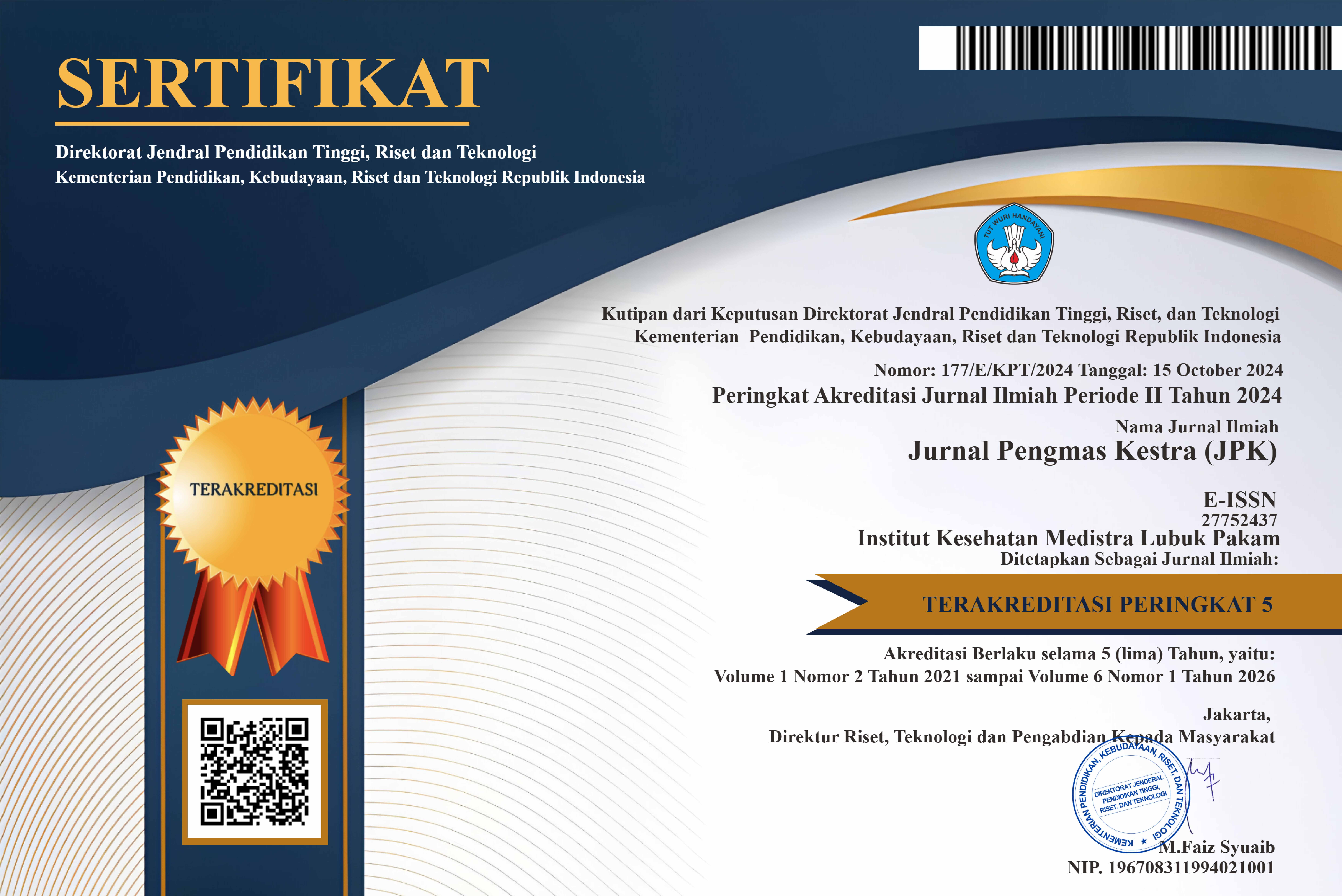Enhancing Awareness of Healthy Lifestyles to Prevent Obesity in Women of Reproductive Age: A Study at Perbarakan Village
DOI:
https://doi.org/10.35451/2sdcnd49Keywords:
Healthy Lifestyle, Obesity, Awareness Enhancement, Women of Reproductive AgeAbstract
Currently, nutritional problems remain a significant public health concern in Indonesia. Economic conditions and increased food consumption levels among the population have contributed to the rising prevalence of obesity. Obesity is a nutritional disorder characterized by excessive fat accumulation in the body. This condition leads to abnormal fat distribution, resulting in decreased muscle mass, quality, and strength. The development of obesity is influenced by poor lifestyle habits, genetic predisposition, and hormonal imbalances. This community service program (PkM) aimed to educate the public on strategies to reduce the risk of obesity by promoting the adoption of healthy lifestyles. The intervention specifically targeted women of reproductive age (WRA), encouraging them to improve their lifestyle practices to prevent obesity-related complications. The program was delivered through lectures, active discussions, and practical field sessions, with a total of 30 participants.During the activity, the PkM team provided health education materials, facilitated interactive question-and-answer sessions, and conducted hands-on training. As a result, there was a significant increase in both knowledge and practical skills among participants. The findings showed a 30-point (51.4%) increase in participants’ knowledge, and 97% of them expressed a strong commitment to adopting healthier behaviors. Moreover, 97% of participants reported high satisfaction with the program, citing the usefulness of the content, engaging materials, and effective delivery methods.This PkM initiative demonstrated its effectiveness in enhancing knowledge and shaping positive attitudes among women of reproductive age regarding healthy lifestyle practices to prevent obesity.
References
[1] R. Meylinda, “Faktor – Faktor Yang Berhubungan dengan Kejadian Obesitas Pada Orang Dewasa Di Wilayah Kerja Puskesmas Air Itam Kota Pangkalpinan,” Nutrition Public Health Faculty, p. 89, 2018.
[2] J. N. Turege, A. Kinasih, and M. D. Kurniasari, “Hubungan Antara Aktivitas Fisik Dengan Obesitas Di Puskesmas Tegalrejo, Kota Salatiga,” Jurnal Ilmu Keperawatan dan Kebidanan, vol. 10, no. 1, p. 256, 2019, doi: 10.26751/jikk.v10i1.530.
[3] I. Pratiwi, A. Masitha Arsyati, and A. Nasution, “Faktor-Faktor Yang Mempengaruhi Kejadian Obesitas Pada Remaja Di Smpn 12 Kota Bogor Tahun 2021,” Promotor, vol. 5, no. 2, p. 156, 2022, doi: 10.32832/pro.v5i2.6150.
[4] A. V. B. Nogueira et al., “Obesity Modifies the Proteomic Profile of the Periodontal Ligament,” International Journal of Molecular Sciences, vol. 24, no. 2, 2023, doi: 10.3390/ijms24021003.
[5] J. L. Atkins and S. G. Wannamathee, “Sarcopenic obesity in ageing: Cardiovascular outcomes and mortality,” British Journal of Nutrition, vol. 124, no. 10, pp. 1102–1113, 2020, doi: 10.1017/S0007114520002172.
[6] A. Savitri, “Faktor-Faktor yang Berhubungan dengan Kejadian Obesitas Sentral pada Wanita Usia 15-44 Tahun di Posbindu Wilayah Kerja Puskesmas Kecamatan Pasar Minggu Jakarta Selatan Tahun 2017,” Journal of Chemical Information and Modeling, vol. 53, no. 9, pp. 1689–1699, 2017.
[7] Tiersa Wulandari, “Hubungan antara faktor aktivitas fisik terhadap obesitas pada kalangan anak sekolah dasar di kota yogyakarta,” Universitas Sanata Dharma, 2017.
[8] W. K. Chea, S. H. Leow, L. S. Ong, C. Erwin, I. Ong, X. W. Ng, and S. L. Loy, “Developing a lifestyle intervention program for overweight or obese preconception, pregnant and postpartum women using qualitative methods,” Scientific Reports, vol. 12, p. 2511, 2022, doi: 10.1038/s41598-022-06564-2.
[9] S. M. Ogunwole, C. A. Zera, and F. C. Stanford, “Obesity management in women of reproductive age,” JAMA, vol. 325, no. 5, pp. 433–434, 2021, doi: 10.1001/jama.2020.21096.
[10] E. Cha, M. J. Smart, B. J. Braxter, and M. S. Faulkner, “Preconception care to reduce the risks of overweight and obesity in women of reproductive age: An integrative review,” International Journal of Environmental Research and Public Health, vol. 18, no. 9, p. 4582, 2021, doi: 10.3390/ijerph18094582.
[11] M. S. A. Kassim, M. R. A. Manaf, N. S. M. Nor, and R. Ambak, “Effects of lifestyle intervention towards obesity and blood pressure among housewives in Klang Valley: A quasi-experimental study,” Malaysian Journal of Medical Sciences, vol. 24, no. 6, pp. 83–91, 2017, doi: 10.21315/mjms2017.24.6.10.
[12] B. Hill, S. McPhie, and H. Teede, “Lifestyle intervention to prevent obesity during pregnancy: Implications and recommendations for research and implementation,” Midwifery, vol. 49, pp. 13–18, 2017, doi: 10.1016/j.midw.2016.09.017.
[13] T. M. Van Elten, M. D. A. Karsten, A. Geelen, R. J. Gemke, H. Groen, A. Hoek, M. N. M. Van Poppel, and T. J. Roseboom, “Preconception lifestyle intervention reduces long-term energy intake in women with obesity and infertility: A randomized controlled trial,” International Journal of Behavioral Nutrition and Physical Activity, vol. 16, p. 3, 2019, doi: 10.1186/s12966-018-0761-6.
[14] L. T. Williams, C. E. Collins, P. J. Morgan, and J. L. Hollis, “Maintaining the outcomes of a successful weight gain prevention intervention in mid-age women: Two-year results from the 40-something randomized control trial,” Nutrients, vol. 11, no. 5, 2019, doi: 10.3390/nu11051160.
[15] J. A. Benítez Andrades, N. Arias, M. T. García Ordás, M. Martínez?Martínez, and I. García Rodríguez, “Feasibility of social network based eHealth intervention on the improvement of healthy habits among children,” arXiv preprint, 2024, doi: 10.48550/arXiv.2403.12073.
Downloads
Published
Issue
Section
License
Copyright (c) 2025 Ika Nur Saputri, Irma Nurianti

This work is licensed under a Creative Commons Attribution 4.0 International License.
Copyright in each article is the property of the Author.




















